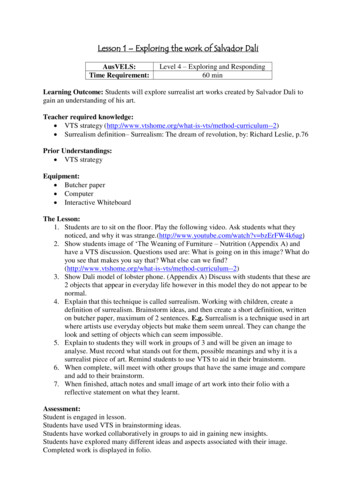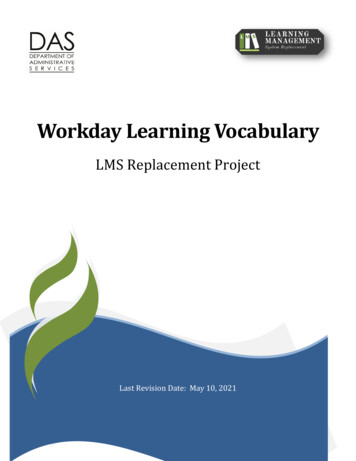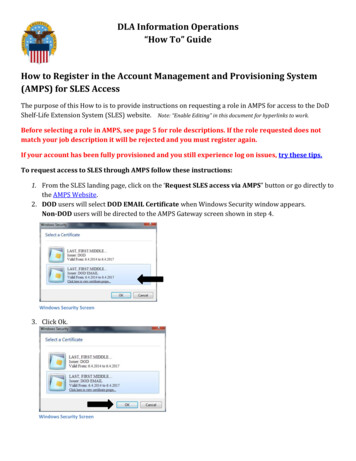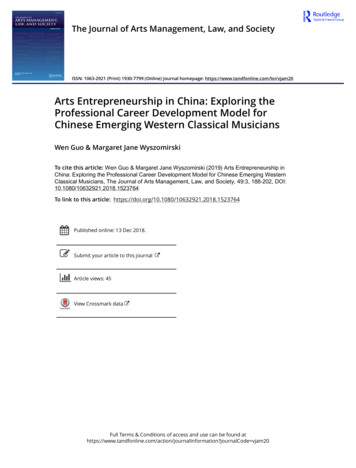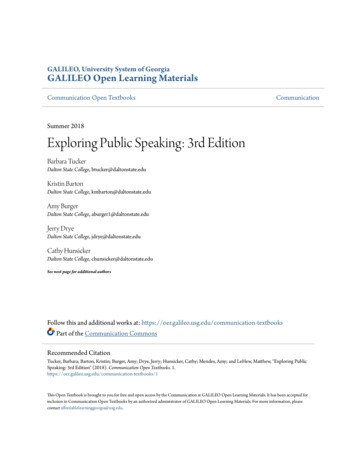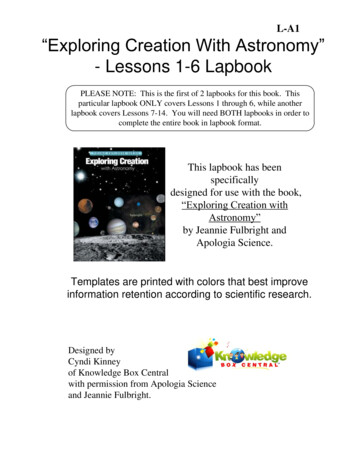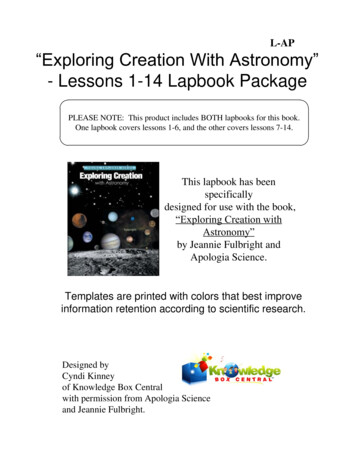
Transcription
Exploring the Role of theHeart in Human PerformanceVolume 2SCIENCEof theHEARTAn overview of research conducted by HeartMath Institute
SCIENCE OF THE HEARTExploring the Role of the Heart in Human PerformanceVolume 2Authored by Rollin McCraty, Ph.D.Director of Research, HeartMath Research CenterPhone: (831) 338-8500Email: info@heartmath.orgVisit our website at https://www.heartmath.orgPublished by: HeartMath InstituteHeartMath Institute14700 West Park Ave.P.O. Box 1463Boulder Creek, CA 95006Distributed in USA by HeartMath InstituteCopyright 2015 by HeartMath InstituteCover and layout design by Sandy RoyallVolume 1 2001Volume 2 2015ISBN 978-1-5136-0636-1 PaperbackAll rights reserved. No part of this book may be translated or reproduced in any formwithout the written permission of HeartMath Institute.HeartMath , Freeze Frame , Heart Lock-In , Cut-Thru , Inner Quality Management (IQM)are registered trademarks of HeartMath Institute.10 9 8 7 6 5 4 3 2 1First printing, November 2015i Copyright 2015 HeartMath Institute
Table of ContentsAbout HeartMath Institute . iiiIntroduction .1Chapter 1: Heart-brain Communication .3Chapter 2: Resilience, Stress and Emotions .8Chapter 3: Heart Rate Variability: An Indicator of Self-Regulatory Capacity,Autonomic Function and Health .13Chapter 4: Coherence .24Chapter 5: Establishing a New Baseline .29Chapter 6: Energetic Communication .36Chapter 7: Intuition Research: Coherence and the Surprising Role of the Heart .45Chapter 8: Health Outcome Studies .53Chapter 9: Outcome Studies in Education .66Chapter 10: Social Coherence: Outcome Studies in Organizations .81Chapter 11: Global Coherence Research: Human-Earth Interconnectivity .89Bibliography .100ii Copyright 2015 HeartMath Institute
About HeartMath InstituteHeartMath Institute (HMI) is an innovative nonprofit research and education organization that provides simple, user-friendly mental and emotion self-regulationtools and techniques that people of all ages and cultures can use in the momentto relieve stress and break through to greater levels of personal balance, stability,creativity, intuitive insight and fulfillment.HMI research has formed the foundation for training programs conductedaround the world in many different types of populations, including major corporations, government and social-service agencies, all branches of the ArmedForces, schools and universities, hospitals and a wide range of health-careprofessionals. The tools and technologies developed at HMI offer hope fornew, effective solutions to the many daunting problems that society currentlyfaces, beginning with restoring balance and maximizing the potential withineach of us.HeartMath Institute’s Mission (HMI)The mission of HeartMath Institute is to help people bring their physical, mental and emotional systems into balanced alignment with their heart’s intuitiveguidance. This unfolds the path for becoming heart-empowered individuals whochoose the way of love, which they demonstrate through compassionate carefor the well-being of themselves, others and Planet Earth.iii Copyright 2015 HeartMath Institute
IntroductionIntroductionNew research shows the human heart is much more than an efficient pump that sustains life.Our research suggests the heart also is an access point to a source of wisdom and intelligencethat we can call upon to live our lives with more balance, greater creativity and enhanced intuitive capacities. All of these are important for increasing personal effectiveness, improvinghealth and relationships and achieving greater fulfillment.This overview will explore intriguing aspects of the science of the heart, much of which is stillrelatively not well known outside the fields of psychophysiology and neurocardiology. We willhighlight research that bridges the science of the heart and the highly practical, research-basedskill set known as the HeartMath System.The heart has been considered the source of emotion, courage and wisdom for centuries. For more than 25years, the HeartMath Institute Research Center has explored the physiological mechanisms by which theheart and brain communicate and how the activity of the heart influences our perceptions, emotions, intuitionand health. Early on in our research we asked, among other questions, why people experience the feeling orsensation of love and other regenerative emotions as well as heartache in the physical area of the heart. In theearly 1990s, we were among the first to conduct research that not only looked at how stressful emotions affectthe activity in the autonomic nervous system (ANS) and the hormonal and immune systems, but also at theeffects of emotions such as appreciation, compassion and care. Over the years, we have conducted many studiesthat have utilized many different physiological measures such as EEG (brain waves), SCL (skin conductance),ECG (heart), BP (blood pressure) and hormone levels, etc. Consistently, however, it was heart rate variability,or heart rhythms that stood out as the most dynamic and reflective indicator of one’s emotional states and,therefore, current stress and cognitive processes. It became clear that stressful or depleting emotions such asfrustration and overwhelm lead to increased disorder in the higher-level brain centers and autonomic nervoussystem and which are reflected in the heart rhythms and adversely affects the functioning of virtually all bodilysystems. This eventually led to a much deeper understanding of the neural and other communication pathwaysbetween the heart and brain. We also observed that the heart acted as though it had a mind of its own and couldsignificantly influence the way we perceive and respond in our daily interactions. In essence, it appeared thatthe heart could affect our awareness, perceptions and intelligence. Numerous studies have since shown thatheart coherence is an optimal physiological state associated with increased cognitive function, self-regulatorycapacity, emotional stability and resilience.We now have a much deeper scientific understanding of many of our original questions that explains how andwhy heart activity affects mental clarity, creativity, emotional balance, intuition and personal effectiveness. Ourand others’ research indicates the heart is far more than a simple pump. The heart is, in fact, a highly complex Copyright 2015 HeartMath Institute1
Science of the Heartinformation-processing center with its own functional brain, commonly called the heart brain, that communicateswith and influences the cranial brain via the nervous system, hormonal system and other pathways. Theseinfluences affect brain function and most of the body’s major organs and play an important role in mental andemotional experience and the quality of our lives.In recent years, we have conducted a number of research studies that have explored topics such as the electrophysiology of intuition and the degree to which the heart’s magnetic field, which radiates outside the body,carries information that affects other people and even our pets, and links people together in surprising ways.We also launched the Global Coherence Initiative (GCI), which explores the interconnectivity of humanity withEarth’s magnetic fields.This overview discusses the main findings of our research and the fascinating and important role the heartplays in our personal coherence and the positive changes that occur in health, mental functions, perception,happiness and energy levels as people practice the HeartMath techniques. Practicing the techniques increasesheart coherence and one’s ability to self-regulate emotions from a more intuitive, intelligent and balanced innerreference. This also explains how coherence is reflected in our physiology and can be objectively measured.The discussion then expands from physiological coherence to coherence in the context of families, workplacesand communities. Science of the Heart concludes with the perspective that being responsible for and increasingour personal coherence not only improves personal health and happiness, but also feeds into and influencesa global field environment. It is postulated that as increasing numbers of people add coherent energy to theglobal field, it helps strengthen and stabilize mutually beneficial feedback loops between human beings andEarth’s magnetic fields. Copyright 2015 HeartMath Institute2
Heart-Brain CommunicationCHAPTER 1Heart-Brain CommunicationTraditionally, the study of communication pathways between the head and heart has been approached froma rather one-sided perspective, with scientists focusing primarily on the heart’s responses to the brain’scommands. We have learned, however, that communication between the heart and brain actually is a dynamic,ongoing, two-way dialogue, with each organ continuously influencing the other’s function. Research has shownthat the heart communicates to the brain in four major ways: neurologically (through the transmission of nerveimpulses), biochemically (via hormones and neurotransmitters), biophysically (through pressure waves) andenergetically (through electromagnetic field interactions). Communication along all these conduits significantlyaffects the brain’s activity. Moreover, our research shows that messages the heart sends to the brain also canaffect performance.The heart communicates with the brain and body in four ways: Neurological communication (nervous system) Biochemical communication (hormones) Biophysical communication (pulse wave) Energetic communication (electromagnetic fields)Some of the first researchers in the field of psychophysiology to examine the interactions between theheart and brain were John and Beatrice Lacey. During20 years of research throughout the 1960s and ’70s,they observed that the heart communicates with thebrain in ways that significantly affect how we perceiveand react to the world.when we are at rest and the brain is in control of theentire process. Cannon also introduced the conceptof homeostasis. Since then, the study of physiologyhas been based on the principle that all cells, tissuesand organs strive to maintain a static or constantsteady-state condition. However, with the introduction of signal-processing technologies that can acquire continuous data over time from physiologicalprocesses such as heart rate (HR), blood pressure(BP) and nerve activity, it has become abundantly apparent that biological processes vary in complex andnonlinear ways, even during so-called steady-stateconditions. These observations have led to the understanding that healthy, optimal function is a result ofcontinuous, dynamic, bidirectional interactions amongmultiple neural, hormonal and mechanical controlsystems at both local and central levels. In concert,these dynamic and interconnected physiological andpsychological regulatory systems are never truly atrest and are certainly never static.In physiologist and researcher Walter Bradford Cannon’s view, when we are aroused, the mobilizing partof the nervous system (sympathetic) energizes us forfight or flight, which is indicated by an increase in heartrate, and in more quiescent moments, the calmingpart of the nervous system (parasympathetic) calmsus down and slows the heart rate. Cannon believedthe autonomic nervous system and all of the relatedphysiological responses moved in concert with thebrain’s response to any given stimulus or challenge.Presumably, all of our inner systems are activated together when we are aroused and calm down together Copyright 2015 HeartMath Institute3
Science of the HeartFor example, we now know that the normal resting rhythm of the heart is highly variable rather than monotonously regular, which was the widespread notion for many years. This will be discussed further in the sectionon heart rate variability (HRV).Figure 1.1 Innervation of the major organs by the autonomic nervous system (ANS). Parasympathetic fibers are primarily in thevagus nerves, but some that regulate subdiaphragmatic organs travel through the spinal cord. The sympathetic fibers also travelthrough the spinal cord. A number of health problems can arise in part because of improper function of the ANS. Emotions canaffect activity in both branches of the ANS. For example, anger causes increased sympathetic activity while many relaxationtechniques increase parasympathetic activity.The Laceys noticed that the model proposed by Cannon only partially matched actual physiological behavior. As their research evolved, they found that theheart in particular seemed to have its own logic thatfrequently diverged from the direction of autonomicnervous system activity. The heart was behaving asthough it had a mind of its own. Furthermore, theheart appeared to be sending meaningful messagesto the brain that the brain not only understood, butalso obeyed. Even more intriguing was that it lookedas though these messages could affect a person’sperceptions, behavior and performance. The Laceysidentified a neural pathway and mechanism wherebyinput from the heart to the brain could inhibit or facilitate the brain’s electrical activity. Then in 1974,French researchers stimulated the vagus nerve (whichcarries many of the signals from the heart to the brain)in cats and found that the brain’s electrical responsewas reduced to about half its normal rate.[1] This suggested that the heart and nervous system were not Copyright 2015 HeartMath Institutesimply following the brain’s directions, as Cannon hadthought. Rather, the autonomic nervous system andthe communication between the heart and brain weremuch more complex, and the heart seemed to haveits own type of logic and acted independently of thesignals sent from the brain.While the Laceys research focused on activity occurring within a single cardiac cycle, they also were ableto confirm that cardiovascular activity influencesperception and cognitive performance, but there werestill some inconsistencies in the results. These inconsistencies were resolved in Germany by Veldenand Wölk, who later demonstrated that cognitiveperformance fluctuated at a rhythm around 10 hertzthroughout the cardiac cycle. They showed that themodulation of cortical function resulted from ascending cardiovascular inputs on neurons in the thalamus,which globally synchronizes cortical activity.[2, 3] Animportant aspect of their work was the finding that4
Chapter 1: Heart-Brain Communicationit is the pattern and stability of the heart’s rhythm ofthe afferent (ascending) inputs, rather than the number of neural bursts within the cardiac cycle, that areimportant in modulating thalamic activity, which inturn has global effects on brain function. There hassince been a growing body of research indicating thatafferent information processed by the intrinsic cardiacnervous system (heart-brain) can influence activityin the frontocortical areas[4-6] and motor cortex,[7] affecting psychological factors such as attention level,motivation,[8] perceptual sensitivity[9] and emotionalprocessing.[10]these ascending neural pathways are related to theheart (and cardiovascular system) than to any otherorgan.[15] This means the heart sends more informationto the brain than the brain sends to the heart. Morerecent research shows that the neural interactionsbetween the heart and brain are more complex thanpreviously thought. In addition, the intrinsic cardiacnervous system has both short-term and long-termmemory functions and can operate independently ofcentral neuronal command.Neurocardiology: The Brain On the HeartWhile the Laceys were conducting their research inpsychophysiology, a small group of cardiologistsjoined forces with a group of neurophysiologists andneuroanatomists to explore areas of mutual interest.This represented the beginning of the new disciplinenow called neurocardiology. One of their early findingsis that the heart has a complex neural network that issufficiently extensive to be characterized as a brain onthe heart (Figure 1.2).[11, 12] The heart-brain, as it is commonly called, or intrinsic cardiac nervous system, is anintricate network of complex ganglia, neurotransmitters, proteins and support cells, the same as those ofthe brain in the head. The heart-brain’s neural circuitryenables it to act independently of the cranial brain tolearn, remember, make decisions and even feel andsense. Descending activity from the brain in the headvia the sympathetic and parasympathetic branchesof the ANS is integrated into the heart’s intrinsic nervous system along with signals arising from sensoryneurons in the heart that detect pressure, heart rate,heart rhythm and hormones.Figure 1.2. Microscopic image of interconnected intrinsiccardiac ganglia in the human heart. The thin, light-bluestructures are multiple axons that connect the ganglia.Courtesy of Dr. J. Andrew Armour.Once information has been processed by the heart’sintrinsic nervous system, the appropriate signals aresent to the heart’s sinoatrial node and to other tissues in the heart. Thus, under normal physiologicalconditions, the heart’s intrinsic nervous system playsan important role in much of the routine control ofcardiac function, independent of the central nervoussystem. The heart’s intrinsic nervous system is vitalfor the maintenance of cardiovascular stability andefficiency and without it, the heart cannot functionproperly. The neural output, or messages from theintrinsic cardiac nervous system travels to the brainvia ascending pathways in the both the spinal columnand vagus nerves, where it travels to the medulla, hypothalamus, thalamus and amygdala and then to thecerebral cortex.[5, 16, 17] The nervous-system pathwaysbetween the heart and brain are shown in Figure 1.3and the primary afferent pathways in the brain areshown in Figure 1.4.The anatomy and functions of the intrinsic cardiac nervous system and its connections with the brain havebeen explored extensively by neurocardiologists.[13, 14]In terms of heart-brain communication, it is generallywell-known that the efferent (descending) pathwaysin the autonomic nervous system are involved in theregulation of the heart. However, it is less appreciatedthat the majority of fibers in the vagus nerves areafferent (ascending) in nature. Furthermore, more of Copyright 2015 HeartMath Institute5
Science of the HeartHad the existence of the intrinsic cardiac nervoussystem and the complexity of the neural communication between the heart and brain been known whilethe Laceys were conducting their paradigm-shiftingresearch, their theories and data likely would havebeen accepted far sooner. Their insight, rigorous experimentation and courage to follow where the dataled them, even though it did not fit the well-entrenchedbeliefs of the scientific community of their day, werepivotal in the understanding of the heart-brain connection. Their research played an important role inelucidating the basic physiological and psychological processes that connect the heart and brain andthe mind and body. In 1977, Dr. Francis Waldropin,director of the National Institute of Mental Health,stated in a review article of the Laceys’ work, “Theirintricate and careful procedures, combined with theirdaring theories, have produced work that has stirredcontroversy as well as promise. In the long run, theirresearch may tell us much about what makes each ofus a whole person and may suggest techniques thatcan restore a distressed person to health.”Heart-BrainCommunication PathwaysBrainCortexHeartSubcortical AreasNodose GanglionVagus Nerves (Parasympathetic)MedullaSpinal Cord(Sympathetic)Extrinsic Cardiac GangliaIntrinsic Nervous SystemSA NodeAV Node(Thoracic Cavity)Chemosensory NeuronsMechanosensory NeuronsSympatheticParasympatheticDorsal RootGanglionSympathetic & parasympathetic outputs tomuscles throughout the heartAfferent PathwaysFigure 1.3. The neural communication pathways interacting between the heart and brain are responsible for the generation of HRV.The intrinsic cardiac nervous system integrates information from the extrinsic nervous system and the sensory neurites within theheart. The extrinsic cardiac ganglia located in the thoracic cavity have connections to the lungs and esophagus and are indirectlyconnected via the spinal cord to many other organs, including the skin and arteries. The vagus nerve (parasympathetic) primarilyconsists of afferent (flowing to the brain) fibers that connect to the medulla. The sympathetic afferent nerves first connect to theextrinsic cardiac ganglia (also a processing center), then to the dorsal root ganglion and the spinal cord. Once afferent signalsreach the medulla, they travel to the subcortical areas (thalamus, amygdala, etc.) and then the higher cortical areas. Copyright 2015 HeartMath Institute6
Chapter 1: Heart-Brain CommunicationFigure 1.4. Diagram of the currently known afferent pathways by which information from the heart and cardiovascular systemmodulates brain activity. Note the direct connections from the NTS to the amygdala, hypothalamus and thalamus. Although notshown, there also is evidence emerging that there is a pathway from the dorsal vagal complex that travels directly to the frontalcortex.The Heart as a Hormonal Glandoutflow[20] and appears to interact with the immunesystem.[21] Even more intriguing, experiments suggestatrial peptide can influence motivation and behavior.[22]In addition to its extensive neurological interactions,the heart also communicates with the brain and bodybiochemically by way of the hormones it produces.Although not typically thought of as an endocrinegland, the heart actually manufactures and secretesa number of hormones and neurotransmitters thathave a wide-ranging impact on the body as a whole.It was later discovered the heart contains cells thatsynthesize and release catecholamines (norepinephrine, epinephrine and dopamine), which areneurotransmitters once thought to be produced onlyby neurons in the brain and ganglia.[23] More recently,it was discovered the heart also manufactures andsecretes oxytocin, which can act as a neurotransmitter and commonly is referred to as the love or socialbonding hormone. Beyond its well-known functionsin childbirth and lactation, oxytocin also has beenshown to be involved in cognition, tolerance, trustand friendship and the establishment of enduringpair-bonds. Remarkably, concentrations of oxytocinproduced in the heart are in the same range as thoseproduced in the brain.[24]The heart was reclassified as part of the hormonalsystem in 1983, when a new hormone produced andsecreted by the atria of the heart was discovered. Thishormone has been called by several different names– atrial natriuretic factor (ANF), atrial natriuretic peptide (ANP) and atrial peptide. Nicknamed the balancehormone, it plays an important role in fluid and electrolyte balance and helps regulate the blood vessels,kidneys, adrenal glands and many regulatory centersin the brain.[18] Increased atrial peptide inhibits therelease of stress hormones,[19] reduces sympathetic Copyright 2015 HeartMath Institute7
Science of the HeartCHAPTER 2Resilience, Stress and EmotionsAs far back as the middle of the last century, it was recognized that the heart, overtaxed by constant emotional influences or excessive physical effort and thus deprived of its appropriate rest, suffers disorders offunction and becomes vulnerable to disease.[25]An early editorial on the relationships between stressand the heart accepted the proposition that in abouthalf of patients, strong emotional upsets precipitatedheart failure. Unspecified negative emotional arousal,often described as stress, distress or upset, has beenassociated with a variety of pathological conditions,including hypertension,[26, 27] silent myocardial ischemia,[28] sudden cardiac death,[29] coronary disease,[30-32]cardiac arrhythmia,[33] sleep disorders,[34] metabolicsyndrome,[35] diabetes,[36, 37] neurodegenerative diseases,[38] fatigue[39, 40] and many other disorders.[41] Stressand negative emotions have been shown to increasedisease severity and worsen prognosis for individualssuffering from a number of different pathologies.[42, 43]On the other hand, positive emotions and effectiveemotion self-regulation skills have been shown toprolong health and significantly reduce prematuremortality.[44-49] From a psychophysiological perspective, emotions are central to the experience of stress.It is the feelings of anxiety, irritation, frustration, lackof control, and hopelessness that are actually what weexperience when we describe ourselves as stressed.Whether it’s a minor inconvenience or a major lifechange, situations are experienced as stressful to theextent that they trigger emotions such as annoyance,irritation, anxiety and overwhelm.[50]Additionally, emotions, much more so than thoughtsalone, activate the physiological changes comprising the stress response. Our research shows a purelymental activity such as cognitively recalling a pastsituation that provoked anger does not produce nearlyas profound an effect on physiological processes asactually engaging the emotion associated with thatmemory. In other words, reexperiencing the feeling ofanger provoked by the memory has a greater effectthan thinking about it.[51, 52]Resilience and Emotion Self-RegulationOur emotions infuse life with a rich texture and transform our conscious experience into a meaningfulliving experience. Emotions determine what we careabout and what motivates us. They connect us toothers and give us the courage to do what needs tobe done, to appreciate our successes, to protect andsupport the people we love and have compassion andkindness for those who are in need of our help. Emotions are also what allow us to experience the painand grief of loss. Without emotions, life would lackmeaning and purpose.Emotions and resilience are closely related becauseemotions are the primary drivers of many key physiological processes involved in energy regulation. Wedefine resilience as the capacity to prepare for, recoverfrom and adapt in the face of stress, adversity, trauma orchallenge.[53] Therefore, it follows that a key to sustaining good health, optimal function and resilience is theability to manage one’s emotions.In essence, stress is emotional unease, the experienceof which ranges from low-grade feelings of emotionalunrest to intense inner turmoil. Stressful emotionsclearly can arise in response to external challengesor events, and also from ongoing internal dialogs andattitudes. Recurring feelings of worry, anxiety, anger,judgment, resentment, impatience, overwhelm andself-doubt often consume a large part of our energyand dull our day-to-day life experiences. Copyright 2015 HeartMath InstituteIt has been suggested that resilience should beconsidered as a state rather than a trait and that aperson’s resilience can vary over time as demands,8
Chapter 2: Resilience, Stress and Emotionscircumstances and level of maturity change.[54] Inour resilience training programs, we suggest thatthe ability to build and sustain resilience is related toself-management and efficient utilization of energyresources across four domains: physical, emotional,mental and spiritual (Figure 2.1). Physical resilienceis basically reflected in physical flexibility, enduranceand strength, while emotional resilience is reflected inthe ability to self-regulate, degree of emotional flexibility, positive outlook and supportive relationships.Mental resilience is reflected in the ability to sustainfocus and attention, mental flexibility and the capacity for integrating multiple points of view. Spiritualresilience is typically associated with commitment tocore values, intuition and tolerance of others’ valuesand beliefs.The ability to adjust and self-regulate also is central toresilience, good health and effective decision-making.[55]It is a key for success in living life with greater kindness and compassion in all relationships. If people’scapacity for intelligent, self-directed regulation isstrong enough, then regardless of inclinations, pastexperiences or personality traits, they usually can dothe adaptive or right thing in most situations.[56]We are coming to understand health not as theabsence of disease, but rather as the process bywhich individuals maintain their sense of coherence (i.e. sense that life is comprehensible, manageable, and meaningful) and ability to functionin the face of changes in themselves and theirrelationships with their environment.[57]It has been shown that our efforts to self-regulate emotions can produce broad improvements in increasingor strengthening self-regulatory capacity, similar tothe process of strengthening a muscle, making usless vulnerable to depletion of our internal reserves.[56]When internal energy reserves are deplet
HeartMath , Freeze Frame , Heart Lock-In . years, the HeartMath Institute Research Center has explored the physiological mechanisms by which the heart and brain communicate and how the activity of the hear


